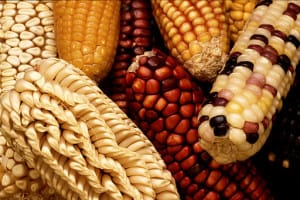FoodTank
by Timothy A. Wise
 |
To listen to the current debates over the controversial requests by Monsanto and other biotech giants to grow genetically modified (GM) maize in Mexico, you’d think the danger to the country’s rich biodiversity in maize was hypothetical. It is anything but.
Studies have found the presence of transgenes in native maize in nearly half of Mexico’s states. A study of maize diversity within the confines of Mexico’s sprawling capital city revealed transgenic maize in 70 percent of the samples from the area of Xochimilco and 49 percent of those from Tlalpan.
Mexico is the “center of origin” where maize was first domesticated from its wild ancestor, teocinte. The country is arguably the last place you’d want to risk the possibility that its wide array of native seeds might be undermined by what indigenous people have called “genetic pollution” from GM maize.
Last October, a judge issued an injunction putting a halt to all experimental and commercial planting until it can be proven that native maize varieties are not threatened by “gene flow” from GM maize. The precautionary measure comes more than a decade too late.
In 2001, US-based researchers discovered the presence of transgenic traits in native maize varieties in the southern state of Oaxaca. A formal citizen complaint brought an exhaustive study by the environmental commission set up by the North American Free Trade Agreement (NAFTA). The researchers acknowledged that “gene flow” had occurred, warned, as other studies did, of more widespread contamination, and called for precautionary policies, including restrictions on imports from the United States.
The Mexican government buried the study and promptly passed a biosafety law that opened the door to GM maize.
“It is Orwellian that this history is unknown,” said Antonio Serratos, one of the researchers on the NAFTA-commissioned study, as well as the studies on Mexico City native maize. He said he was surprised by two things in Mexico City.
“First, that we found so much diversity. In an area so small, so urban, it was so unlikely,” he said. “The other surprise was finding transgenics.”
“In Mexican fields,” Serratos warned, “transgenic native maize is being created.”
That possibility did not seem to concern representatives of Monsanto Mexico, beyond a passing mention. “We are very sensitive to Mexico being a center of origin, to the cultural significance of maize,” Jaime Mijares Noriega, Monsanto’s Latin America Director for Corporate Affairs, said in the company’s Mexico City office. “But if there is pollen flow to native maize, what happens? There are very few pure landraces in Mexico today. Many have already gotten genes from hybrids, and the native seeds are preserved in gene banks.”
According to Oscar Heredia, the company’s Agronomic Regulatory Affairs officer, the company-funded field trials in northern Mexico showed minimal gene flow from GM maize to non-GM maize in bordering plots, dropping to less than 0.5 percent of plants. I asked if the company’s goal was to achieve zero percent gene flow. He said that would be unrealistic.
Indeed it would, which is why people are concerned. Serratos told me that maize pollen has been known to travel more than one kilometer.
He explained the danger: A hectare will have about 40,000 plants. One-half a percent of that is 200 plants. Each plant has about 400 grains on a few ears of maize, with each grain pollinated separately through the plant’s silk threads. If 200 plants get some level of contamination, that can mean up to 80,000 grains. And, if any of those grains are planted as seed, they will produce pollen, even if they don’t produce usable ears of maize. That pollen travels the winds, further spreading the transgenes.
Serratos pointed out that wind-borne gene flow isn’t even the most pervasive source of contamination. Seeds travel far and wide, in farmers’ pockets. Small-scale farmers are relentless experimenters, trying every seed they get their hands on to see if it produces something useful. That’s how maize has evolved into the wide and useful range of varieties we see today. That is also how imported GM maize traveled to Oaxaca, got planted by an unwitting farmer, and spread transgenes to native plants.
I asked Monsanto officials how they expected to control this more pervasive form of gene flow. “We can’t really ensure how grains are transported and where they end up,” Heredia said.
Serratos stressed that this is precisely why precaution is warranted, why the entire country should be declared a “center of origin” for maize, with no permitted GM cultivation. Well-intentioned farmers could already be storing contaminated native seeds in their own community seed banks.
”If the seeds of maize are sold or exchanged, the contamination will grow exponentially,” he warned. “That is the point of no return.”
Timothy A. Wise is the Policy Research Director at Tufts University’s Global Development and Environment Institute (GDAE). He is currently researching agriculture, climate change and the right to food as part of a project on “A Rights-based Approach to the Global Food Crisis.”

